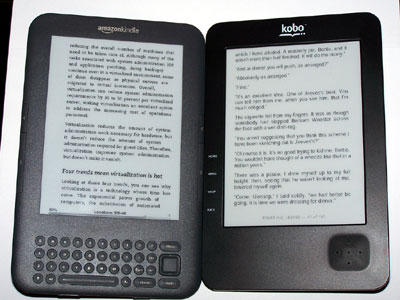
Ever since one of my Piker Press colleagues wrote a glowing review of her Nook, I've been wondering if I needed an e-reader of my own. Like her, I sometimes have PDF files I would like to carry with me. Also, when packing for a trip, I spend far more time than is necessary deciding which books I should take. As often as not, I decide on some lunker like a hardback of Don Quixote, plus a couple of other things just in case that doesn't work out. Trying to fly with a carry-on full of books is, in short, madness.
Late last year, my husband jumped the gun on me and bought himself a Kindle. This was important to me because it gave me a chance to give the e-reading experience a test run. I took it to an appointment for an eye exam. After the nurse put dilating drops in my eyes, I ditched my usual large-print Reader's Digest, and opened up a book on the Kindle. I had to increase the font size three times before the doctor finished the exam, but by then I was hooked.
Recently, Border's had their Kobo reader on sale for $99.99, coincidentally at a time when I had accomplished something gift-worthy. After trying it out in the store, and obsessing about it for a couple of days, I decided to buy it.
I knew up-front that that Kobo was not in Kindle's league. Kindle is loaded with features. If Kindle is a Cadillac, then Kobo is an Aveo. It will get you where you want to go, but it doesn't provide a lot of extra entertainment along the way.
Kobo did have two important features that are lacking in Kindle, though. First, it came pre-loaded with 100 classic public domain books. Don Quixote? Already in there. Dickens, Twain, Austen, Tolstoy? In there. The "I should read more classic literature" problem was solved right out of the box.
Kobo's other big advantage seems like a disadvantage at first. It only accepts two document formats, EPUB and PDF. However, EPUB is a standard format used for book downloads at sites such as Project Gutenberg, so it opens up a whole world of free books. Kindle doesn't read EPUB downloads unless they are converted into the Kindle-friendly MOBI format.
Kobo is roughly the same size as the Kindle -- a bit thicker, but a little lighter. Where Kindle has a full physical keyboard and page-turn buttons on both the left and right sides, Kobo just has a five-way navigation pad on the front, and four buttons down the side. I actually find Kobo's page and menu navigation to be more intuitive than Kindle's, but my opinion might be different if I were left-handed, or if I routinely used the device in landscape mode.
Kindle's keyboard, though, is key to some of its advanced features such as note taking, searching, web browsing, or game playing. (You do not know the meaning of "wasted time" until you have tried playing Minesweeper on a Kindle.) Kobo does none of those things, nor does it allow bookmarking, other than remembering how far you have read. That's not a necessarily a drawback for pleasure reading, but might be a consideration for study or technical reading.
Kindle offers more options for adjusting its display, with three fonts to Kobo's two, and eight font sizes to Kobo's five. Kindle also had additional options such as line spacing. Kobo is quite readable under most circumstances, though, and the font size can be changed quickly from the navigation pad without having to open a menu. If you have vision concerns, also be aware that the print on Kindle's keyboard is quite small.
The e-ink technology used by Kobo is a little behind Kindle. Kobo is slower to start up, and page turns are not quite as zippy as with Kindle. The screens are very similar on both readers. Any screen glare can be eliminated with a slight adjustment to the tilt of the device.
Both readers connect to their respective stores either wirelessly, or with a USB cable. (The cable is also used to charge the devices.) Kindle also has a 3G model available. I have downloaded free books from the Kobo store, EPUBs from Gutenberg, and PDF books from writer friends. Adding books from a source other than the Kobo store was a simple drag-and-drop procedure. One nice feature with Kindle is the ability to e-mail a file to a special address, and have it sync to Kindle automatically. Kindle has the advantage on internal storage space, but Kobo has an SD card slot, giving it essentially unlimited storage, at least for non-DRM documents.
If you need a full-featured reader that allows you to digitally dog-ear your books, write in the margins, and shop from your car as you drive across Wyoming, then Kindle will give you everything you need. On the other hand, if you just want to read a good story without having to learn a lot of new technology, Kobo fills the bill.

02/14/2011
05:37:10 PM